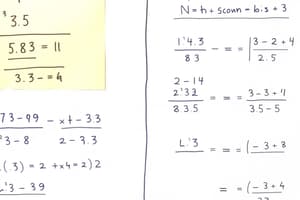Podcast
Questions and Answers
In direct ______ when one quantity increases the other quantity increases or decreases at the same rate.
In direct ______ when one quantity increases the other quantity increases or decreases at the same rate.
proportion
In inverse proportion when one quantity increases the other quantity ______ at the same rate.
In inverse proportion when one quantity increases the other quantity ______ at the same rate.
decreases
In direct proportion, the whole is divided into parts that are proportional to the given ratio.
In direct proportion, the whole is divided into parts that are proportional to the given ratio.
True (A)
In inverse proportion, the whole is divided into parts that are proportional to the given ratio.
In inverse proportion, the whole is divided into parts that are proportional to the given ratio.
In direct proportion, when one quantity increases the other quantity increase or decreases.
In direct proportion, when one quantity increases the other quantity increase or decreases.
In inverse proportion, when one quantity increases the other quantity increases.
In inverse proportion, when one quantity increases the other quantity increases.
Flashcards
Direct Proportion
Direct Proportion
When one quantity increases, the other quantity increases at the same rate.
Inverse Proportion
Inverse Proportion
When one quantity increases, the other quantity decreases at the same rate.
Partitive Proportion
Partitive Proportion
The whole is divided into parts proportional to a given ratio.
Direct Proportion Example
Direct Proportion Example
Signup and view all the flashcards
Inverse Proportion Example
Inverse Proportion Example
Signup and view all the flashcards
Partitive Proportion Example
Partitive Proportion Example
Signup and view all the flashcards
Proportion
Proportion
Signup and view all the flashcards
Which proportion is 'opposite'?
Which proportion is 'opposite'?
Signup and view all the flashcards
What is a 'whole' divided into?
What is a 'whole' divided into?
Signup and view all the flashcards
What increases as another quantity increases, in direct proportion?
What increases as another quantity increases, in direct proportion?
Signup and view all the flashcards
What is a percentage?
What is a percentage?
Signup and view all the flashcards
What is the 'base'?
What is the 'base'?
Signup and view all the flashcards
What's the 'rate'?
What's the 'rate'?
Signup and view all the flashcards
Formula: P = B × R
Formula: P = B × R
Signup and view all the flashcards
Alternative formula: R = P ÷ B
Alternative formula: R = P ÷ B
Signup and view all the flashcards
Alternative formula: B = P ÷ R
Alternative formula: B = P ÷ R
Signup and view all the flashcards
Triangular Representation
Triangular Representation
Signup and view all the flashcards
Example: 25% of 100 is?
Example: 25% of 100 is?
Signup and view all the flashcards
Example: 50 is 20% of what?
Example: 50 is 20% of what?
Signup and view all the flashcards
Example: What percentage of 200 is 40?
Example: What percentage of 200 is 40?
Signup and view all the flashcards
Study Notes
Direct Proportion
- When one quantity increases, the other quantity increases at the same rate.
- When one quantity decreases, the other decreases at the same rate.
Inverse Proportion
- When one quantity increases, the other quantity decreases at the same rate.
- When one quantity decreases, the other increases at the same rate.
Partitive Proportion
- A whole is divided into parts that are proportional to a given ratio.
Studying That Suits You
Use AI to generate personalized quizzes and flashcards to suit your learning preferences.




